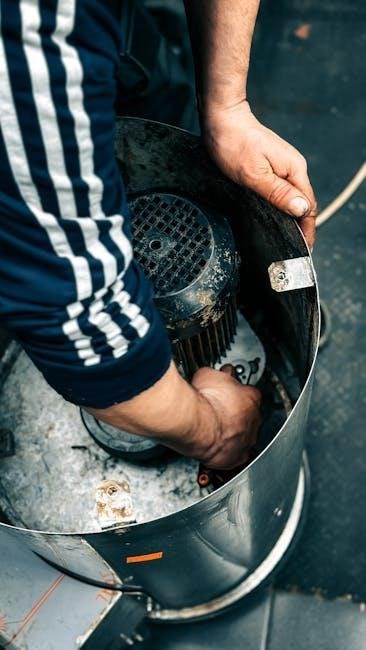The Yamaha Outboard Motor Manual is an essential guide for understanding proper operation, maintenance, and troubleshooting of Yamaha outboard motors, ensuring safety, performance, and longevity.
Overview of Yamaha Outboard Motors
Yamaha outboard motors are renowned for their reliability, durability, and innovative technology, catering to a wide range of marine applications. Available in horsepower ratings from 2 to 250 HP, these motors are designed to deliver exceptional performance, fuel efficiency, and quiet operation. Whether for recreational boating or commercial use, Yamaha offers both 2-stroke and 4-stroke engines, ensuring compatibility with various boat types and user preferences. Their lightweight yet robust design enhances maneuverability and overall boating experiences. Yamaha’s commitment to environmental sustainability is evident in their adherence to emissions standards and eco-friendly practices, making them a trusted choice for marine enthusiasts worldwide.
Importance of the Manual for Proper Operation
The Yamaha Outboard Motor Manual is crucial for ensuring safe and efficient operation. It provides detailed instructions for installation, maintenance, and troubleshooting, preventing potential risks and optimizing performance. By following the manual, users can avoid common mistakes, such as improper fuel handling or electrical component damage. It also outlines essential safety precautions and emergency procedures, ensuring operator and vessel safety. Regular adherence to the manual’s guidelines helps maintain the motor’s reliability and longevity. Ignoring the manual can lead to performance issues, safety hazards, or even voiding the warranty. Proper operation, as per the manual, ensures a smooth and trouble-free boating experience.
Structure and Content of the Manual
The Yamaha Outboard Motor Manual is organized into clear sections for easy navigation. It begins with an introduction, followed by safety precautions, installation guidelines, and detailed maintenance procedures. The manual also includes troubleshooting sections for common issues and provides information on parts and accessories. Environmental considerations and storage tips are covered to ensure longevity. Appendices offer additional resources, such as model-specific details and warranty information. The content is designed to be user-friendly, with diagrams and step-by-step instructions to guide owners through proper operation, maintenance, and repairs, ensuring optimal performance and safety for Yamaha outboard motors.

Safety Precautions and Warnings
Ensure safe operation by following guidelines on fuel handling, electrical components, and emergency procedures. Always wear protective gear and consult the manual for specific precautions and warnings.
General Safety Guidelines
Always wear a U.S. Coast Guard-approved life jacket while operating the outboard motor. Ensure the boat is loaded within weight limits and balance passengers evenly. Avoid operating in bad weather or rough waters. Keep children away from controls unless supervised. Never start the engine without ensuring the propeller is clear of debris. Use the kill switch for emergencies. Be aware of carbon monoxide risks and maintain proper ventilation; Follow all local boating regulations. Read the manual thoroughly before operation. Proper training and experience are essential for safe handling. Regularly inspect the motor and boat for damage or wear. Secure the motor when not in use to prevent theft or accidental start-up.
Handling Fuel and Chemicals
Proper handling of fuel and chemicals is crucial for safe and efficient operation. Always use the recommended fuel type specified in the manual to avoid engine damage. Store fuel in approved containers, away from open flames or sparks; When refueling, ensure the area is well-ventilated to prevent inhaling fumes. Avoid overfilling the tank to allow expansion space. For chemical handling, wear appropriate protective gear, including gloves and eyewear. Dispose of waste materials like oil and filters responsibly, adhering to local regulations. Never mix chemicals, and follow the manual’s guidelines for cleaning products to avoid damaging components or harming the environment.
Precautions for Electrical Components
When working with electrical components of your Yamaha outboard motor, always disconnect the battery to prevent accidental start-ups. Avoid exposing electrical parts to water or moisture, as this can lead to corrosion or short circuits. Use genuine Yamaha connectors and wiring to ensure compatibility and safety. Regularly inspect electrical connections for wear or damage and clean them to maintain proper conductivity. Never attempt to repair complex electrical systems without proper tools or expertise. Grounding issues should be addressed immediately to prevent malfunctions. Follow the manual’s guidelines for voltage checks and protect the system from power surges. Always use corrosion-resistant materials to ensure longevity.
Emergency Procedures
In case of an emergency, immediately shut off the engine and engage the kill switch. Use a portable fire extinguisher if a fire occurs. If the motor overheats, stop the engine and allow it to cool. For propeller damage, avoid operation until repaired. Always carry essential tools and a first-aid kit. In water emergencies, ensure all safety gear is accessible. Refer to the manual for detailed emergency protocols to ensure safety and prevent further damage. Proper emergency procedures help protect both the operator and the outboard motor, ensuring safe and effective resolution of critical situations. Always prioritize caution and preparedness.
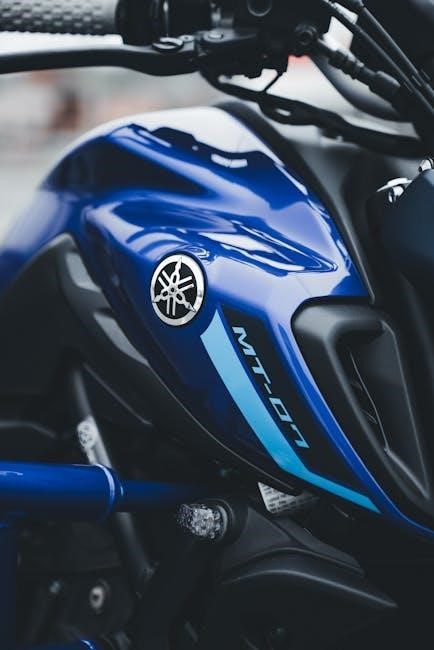
Installation and Setup
Disconnect the battery before installation. Mount the motor securely, ensuring proper alignment. Connect electrical components carefully and test throttle controls. Follow manual guidelines for precise setup.
Mounting the Outboard Motor
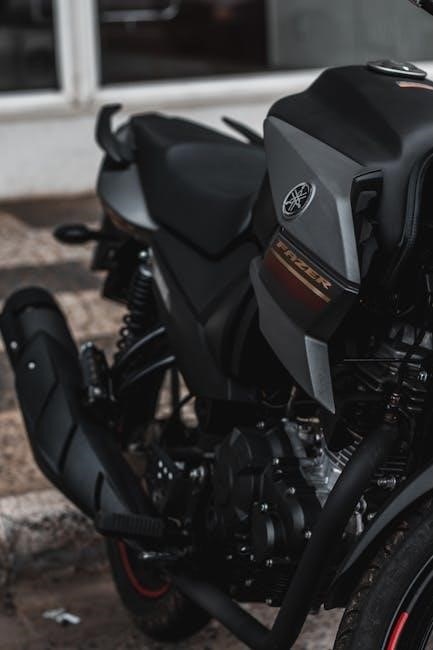
Mounting the Yamaha outboard motor requires careful alignment with the boat’s transom to ensure proper fitment and stability. Secure the motor using the provided hardware, following torque specifications from the manual. Ensure all electrical connections are properly attached and double-check for any obstructions. After installation, test the motor’s movement to confirm smooth operation. Always refer to Yamaha’s guidelines for specific model requirements to avoid damage or safety hazards. Proper mounting is crucial for optimal performance and longevity of the outboard motor.
Control Systems and Throttle Adjustment
The control systems on Yamaha outboard motors are designed for precise operation and ease of use. Proper throttle adjustment ensures smooth acceleration and optimal performance. Begin by setting the throttle to the neutral position and engaging the gearshift smoothly. For manual controls, synchronize the throttle and shift levers to avoid misalignment. Always follow the manufacturer’s guidelines for adjusting the throttle cable tension to prevent slippage or resistance. Regular lubrication of control components is essential to maintain responsiveness. Refer to the manual for specific adjustment procedures tailored to your motor model to ensure safety and peak performance during operation.
Propeller Installation and Alignment
Proper installation and alignment of the propeller are critical for optimal performance and safety. Begin by removing the protective cover from the propeller shaft and ensuring all surfaces are clean. Apply a thin layer of marine grease to the shaft before installing the propeller. Tighten the propeller nut securely using a wrench, following the torque specifications in the manual. Check the alignment to ensure the propeller is straight and properly seated. Misalignment can lead to vibrations and reduced efficiency. Use a propeller alignment tool if necessary. Correct installation ensures smooth operation, fuel efficiency, and longevity of the outboard motor.
Break-In Procedures
Proper break-in is crucial for ensuring the longevity and performance of your Yamaha outboard motor. Begin by rinsing the motor with fresh water to remove any debris. Operate the motor at a low RPM for the first few hours to allow the engine to adjust. Avoid over-revving or prolonged idling. After initial use, inspect the cooling system for blockages. Repeat this process for the first 10 hours of operation. Regularly check oil levels and filter condition during this period. Follow the manual’s guidelines to ensure a smooth and effective break-in process.

Maintenance and Servicing
Regular maintenance is crucial for optimal performance, longevity, and safety of Yamaha outboard motors, ensuring proper functioning and preventing potential issues through systematic checks and servicing.
Routine Maintenance Schedule
Regular maintenance is crucial for optimal performance and longevity of your Yamaha outboard motor. The routine maintenance schedule includes tasks such as oil changes every 50 hours, replacement of fuel and oil filters every 100 hours, and inspection of propellers and lower unit lubrication every 200 hours. Additionally, spark plugs should be replaced every 300 hours, and the cooling system should be checked annually. Always use Yamaha-approved oils and filters to ensure compatibility. Refer to your manual for specific intervals and procedures tailored to your model. Adhering to this schedule ensures reliability, reduces wear, and prevents unexpected breakdowns.
Oil and Lubrication Requirements
Proper oil and lubrication are crucial for the longevity and performance of your Yamaha outboard motor. Always use Yamaha-recommended marine engine oil, as specified in the manual, to ensure compatibility and optimal engine protection. Regular oil changes are essential, typically every 50 to 100 hours of operation, depending on usage conditions. Failure to use the correct oil type can lead to engine damage or void the warranty. Additionally, lubricate moving parts as directed to prevent wear and corrosion. Refer to the manual for specific guidelines on oil viscosity and lubrication points to maintain your motor’s health and performance.
Filter Replacement and Cleaning
Regular filter replacement and cleaning are critical for maintaining the performance and longevity of your Yamaha outboard motor. The fuel filter, air filter, and oil filter should be inspected and replaced according to the schedule outlined in the manual. Fuel filters should be replaced every 100 hours of operation or as specified. Air filters can be cleaned with compressed air but must be replaced if damaged. Oil filters should be changed during routine oil replacements. Always use genuine Yamaha filters to ensure compatibility and optimal performance. Neglecting filter maintenance can lead to engine damage and reduced efficiency. Follow the manual’s step-by-step guide for proper replacement procedures.
Cooling System Inspection
Regular inspection of the cooling system ensures optimal performance and prevents overheating. Check hoses for cracks, leaks, or blockages. Verify that water pump impellers are free from damage or debris. Inspect the thermostat for proper operation and replace if faulty. Flush the cooling system periodically to remove corrosion or scale buildup. Ensure all connections are secure to maintain proper water flow. Refer to the manual for specific intervals and procedures tailored to your Yamaha outboard motor model. A well-maintained cooling system prolongs engine life and prevents costly repairs. Always follow safety guidelines when handling cooling system components.

Troubleshooting Common Issues
This section helps identify symptoms, diagnose problems, and resolve common issues such as engine performance, starting, cooling, and electrical system malfunctions in Yamaha outboard motors effectively.
Diagnosing Engine Performance Problems
Diagnosing engine performance issues in Yamaha outboard motors involves identifying symptoms like rough running, overheating, or loss of power. Check fuel quality, filter condition, and spark plugs for wear or fouling. Air leaks in the intake system or faulty ignition components can also cause poor performance. Use diagnostic tools like compression testers or spark meters to pinpoint issues. Consult the manual for specific troubleshooting steps and refer to Yamaha’s service guidelines for repair procedures; Addressing problems early prevents further damage and ensures optimal engine operation. Always follow safety precautions when working with electrical or fuel systems. Regular maintenance helps minimize issues.
Addressing Starting and Ignition Issues
Starting and ignition issues with Yamaha outboard motors can often be traced to the battery, starter motor, or spark plug system. Always check the battery terminals for corrosion and ensure proper connections. If the motor fails to turn over, inspect the starter motor and solenoid for faults. Spark plugs should be clean and properly gapped, as fouled plugs can prevent ignition. Additionally, verify the ignition coil’s output and ensure the kill switch is functioning correctly.Consult the manual for specific diagnostic steps, as improper troubleshooting can lead to further damage. Regular maintenance, like replacing spark plugs and inspecting wiring, can prevent these issues.
Fixing Cooling System Malfunctions
To address cooling system malfunctions, inspect for blockages in water intake or exhaust. Check hoses for cracks or leaks and ensure the water pump impeller is free from debris; Clean or replace components as needed. If overheating occurs, verify thermostat function and coolant levels. For persistent issues, consult a Yamaha service manual or contact a certified technician to avoid engine damage. Regular maintenance, such as flushing the cooling system, can prevent future malfunctions and ensure optimal performance.
Repairing Electrical System Faults
Identifying and repairing electrical system faults in Yamaha outboard motors requires careful diagnosis. Start by checking wiring connections, fuses, and relays for damage or corrosion. Use a multimeter to test voltage and continuity in circuits. Common issues include faulty sensors, corroded terminals, or loose connections. Refer to the wiring diagram in the manual for specific components. Replace damaged fuses or relays with genuine Yamaha parts. For complex faults, such as ECU malfunctions, consult a certified Yamaha technician. Regularly inspect electrical components and clean connections to prevent issues. Always follow safety guidelines when working with electrical systems to avoid accidents or further damage.

Parts and Accessories
Genuine Yamaha parts ensure reliability and performance, while compatible accessories enhance functionality. Always verify part numbers and compatibility for your specific outboard motor model before installation.
Identifying Genuine Yamaha Parts
To ensure reliability and performance, always use genuine Yamaha parts for your outboard motor. Genuine parts can be identified by Yamaha’s official logo, unique part numbers, and packaging. The serial number on the motor matches the parts catalog. Counterfeit parts may lack proper branding or have inconsistent packaging. For verification, refer to Yamaha’s official website or consult an authorized dealer. Using genuine parts guarantees compliance with warranty terms and maintains optimal engine performance. Always purchase from Yamaha-authorized dealers to avoid counterfeit products that could compromise safety and durability.
Accessorizing for Enhanced Performance
Accessorizing your Yamaha outboard motor can significantly enhance its performance, efficiency, and overall boating experience. Yamaha offers a range of genuine accessories designed to optimize your motor’s capabilities. Propellers, fuel systems, and trim tabs are popular upgrades that improve speed, fuel efficiency, and maneuverability. Additionally, advanced electronics like GPS and fish finders can be integrated for better navigation and fishing experiences. Always ensure accessories are compatible with your motor’s model and adhere to Yamaha’s specifications. Consulting the manual or a Yamaha expert is recommended to avoid installation errors and maintain warranty validity.
Compatibility of Aftermarket Parts
When considering aftermarket parts for your Yamaha outboard motor, it’s crucial to verify compatibility to ensure proper function and avoid potential damage. Yamaha recommends using genuine parts to maintain performance and warranty validity. While some aftermarket components may fit, they could compromise engine efficiency or lead to system malfunctions. Always consult Yamaha’s official compatibility lists or contact authorized dealers to confirm suitability. Using non-approved parts may void your warranty and pose safety risks. Prioritize genuine Yamaha accessories for optimal reliability and adherence to manufacturer standards, ensuring your motor operates as intended for years to come.
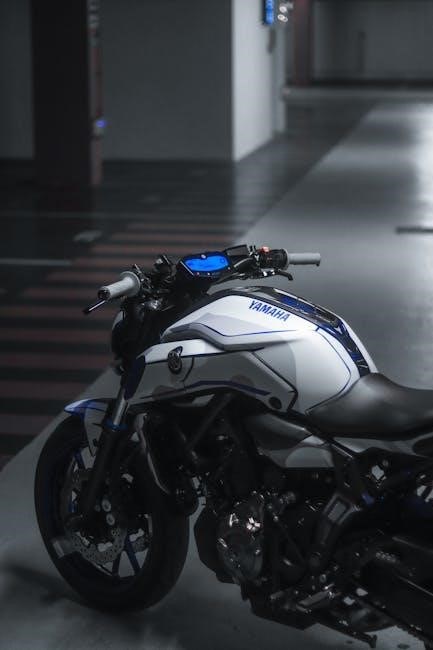
Warranty and Support
Yamaha offers comprehensive warranty coverage and dedicated customer support, ensuring reliable service and extended protection for your outboard motor, enhancing your ownership experience and peace of mind.
Understanding Yamaha Warranty Terms
Yamaha outboard motor warranties provide coverage for defects in materials and workmanship, typically lasting for a specified period or operating hours. The warranty ensures repairs or replacements are performed by authorized service centers. Coverage details, including duration and conditions, are outlined in the manual. Proper maintenance and adherence to guidelines are required to maintain warranty validity. Extended warranty options may be available for additional protection. Always review the terms to understand what is covered and any limitations. Contacting Yamaha’s customer support or visiting authorized service centers can provide further clarification and assistance with warranty-related inquiries.
Service Centers and Customer Support
Yamaha offers a network of authorized service centers worldwide, staffed by trained technicians to ensure expert maintenance and repairs. Customers can access online resources, including manuals, troubleshooting guides, and FAQs, for self-assistance. Yamaha’s customer support teams provide assistance via phone, email, or live chat, addressing queries on operation, maintenance, and warranty. Additionally, Yamaha dealerships offer genuine parts and accessories, ensuring compatibility and quality. Emergency support is available for critical issues, guaranteeing minimal downtime for outboard motor users. Yamaha’s commitment to customer satisfaction is reflected in its comprehensive support system, designed to maximize performance and longevity of their outboard motors.
Extended Warranty Options
Yamaha offers extended warranty options to provide additional protection and peace of mind beyond the standard warranty period. These options can be purchased to cover repairs and replacements for parts and labor due to defects in materials or workmanship. Extended warranties are available for a specified period and can be added within a certain timeframe after the initial purchase. Coverage varies by region and model, so it’s essential to consult with authorized Yamaha dealers or service centers for detailed terms and conditions. Extended warranty plans ensure continued support and maintenance, helping to maintain your outboard motor’s performance and longevity.

Environmental Considerations
Yamaha outboard motor manual emphasizes eco-friendly operation, proper waste disposal, and emissions compliance, aligning with environmental regulations and promoting sustainable boating practices responsibly.
Eco-Friendly Operation Practices
Yamaha outboard motors are designed to minimize environmental impact. To operate eco-friendly, use four-stroke engines, which reduce emissions and fuel consumption. Regular maintenance ensures optimal performance and lowers emissions. Avoid over-revving and maintain a steady speed to conserve fuel. Dispose of waste materials like oil and filters responsibly. Follow local regulations and avoid operating in sensitive ecosystems. Yamaha promotes sustainable boating practices to protect marine environments while delivering reliable power and efficiency for a greener future.
Proper Disposal of Waste Materials
Yamaha emphasizes environmental responsibility by ensuring proper disposal of waste materials from outboard motor maintenance.Dispose of used oil, filters, and batteries responsibly through authorized recycling centers. Coolant and other hazardous substances must be handled according to local regulations. Always consult local waste management guidelines to prevent environmental contamination. Yamaha recommends using certified facilities for hazardous waste disposal to promote eco-friendly practices. Proper disposal helps maintain marine ecosystems and reduces pollution. Refer to Yamaha’s environmental guide for detailed instructions on safely managing waste materials generated during motor servicing and operation.
Compliance with Emissions Standards
Yamaha outboard motors are designed to meet stringent emissions standards set by regulatory bodies worldwide, such as the U.S. Environmental Protection Agency (EPA) and the California Air Resources Board (CARB). These engines incorporate advanced technologies like fuel injection systems and catalytic converters to minimize harmful emissions. Yamaha’s commitment to environmental sustainability ensures that their outboard motors not only deliver exceptional performance but also adhere to global eco-friendly standards. By complying with emissions regulations, Yamaha helps reduce environmental impact while providing reliable and powerful propulsion solutions for boating enthusiasts.
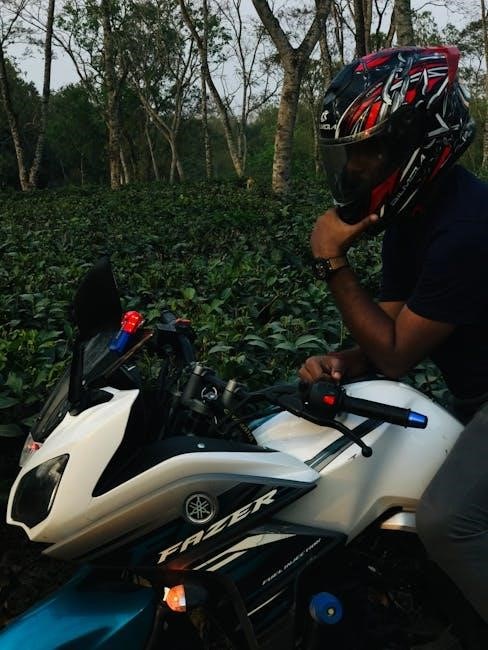
Storage and Transportation
Proper storage and transportation techniques ensure your Yamaha outboard motor remains in excellent condition. Always winterize the motor, clean thoroughly, and use protective covers during storage.
Preparing the Motor for Storage
Preparing your Yamaha outboard motor for storage is crucial to maintain its performance and longevity. Start by dismounting the motor and flushing the engine with fresh water to remove any debris or corrosive substances. Drain the fuel tank or stabilize the fuel to prevent degradation. Apply a rust-inhibiting coating to metal components and fog the engine cylinders. Store the motor in a dry, well-ventilated area, covered with a breathable material to protect against dust and moisture. Follow the manual’s winterization procedures to ensure the motor remains in optimal condition during extended periods of inactivity.
Transportation Safety Tips
When transporting your Yamaha outboard motor, ensure it is securely fastened to a sturdy trailer or carrier to prevent shifting or damage. Use tie-down straps to stabilize the motor and protect it from road vibrations. Cover the motor with a high-quality cover to shield it from dust, moisture, and debris. Avoid overloading the trailer and ensure proper weight distribution. Regularly inspect the trailer and tires before long trips. Always follow local towing regulations and drive cautiously, especially in adverse weather conditions. Proper transportation practices help maintain the motor’s condition and ensure safe arrival at your destination.
Winterization Procedures
Winterization is crucial for protecting your Yamaha outboard motor during cold months. Drain the cooling system to prevent freezing, and flush with freshwater. Treat fuel with a stabilizer to maintain freshness. Change gear oil in the lower unit as per manual instructions. Fog the engine with oil to prevent rust, ensuring the motor runs during application. Protect the propeller with a rust-inhibiting coating. Disconnect and store the battery in a dry place. Lubricate trim and tilt mechanisms, and cover the motor to shield from dust and elements. Always follow the Yamaha manual for model-specific steps to ensure longevity and optimal performance.
